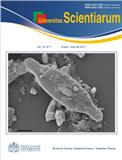Abstract
The ionotropic glutamate receptors activated by N-Methyl-D-Aspartate (iGluR-NMDA) are of great importance in pharmacology since they are involved in neurodegenerative and neuropsychiatric disorders; they even participate in processes such as synaptic plasticity that are essential for memory formation. Subunit NR1 iGluRs-NMDA is of paramount importance for the appropriate activation of this type of receptors; in fact, many of the pharmaceutical products studied for the abovementioned disorders are targeted specifically to the NR1 subunit. Previous studies have shown that the lowest energy unoccupied molecular orbital (LUMO) can be used as a parameter to estimate the agonist and antagonist activity of the NR1subunit. Objective. Evaluate the semiemprical method CNDO for the rapid calculation of the LUMO energy with the aim of preparing a simple model for the in silico design of new pharmacological substances. Materials and methods. 168 molecules with agonist and antagonist activity in the NR1 subunit were selected. Energy of each structure was optimized and then we calculated the energy of the frontier orbital, the LogP, total energy, capacity of forming hydrogen bonds, binding energy, and dipolar moment. Results. We demonstrate that LUMO energy is enough for discriminating agonist and antagonist molecules of the NR1 subunit and that the CNDO method evaluates these properties in a rapid and efficient way. Conclusions. The CNDO method facilitates a rapid calculation, enabling a future development of effective procedures for the characterization of potential pharmacological substances acting on this particular site.
Key words: iGluR-NMDA, LUMO, agonist, antagonist, CNDO
Univ. Sci. is registered under a Creative Commons Attribution 4.0 International Public License. Thus, this work may be reproduced, distributed, and publicly shared in digital format, as long as the names of the authors and Pontificia Universidad Javeriana are acknowledged. Others are allowed to quote, adapt, transform, auto-archive, republish, and create based on this material, for any purpose (even commercial ones), provided the authorship is duly acknowledged, a link to the original work is provided, and it is specified if changes have been made. Pontificia Universidad Javeriana does not hold the rights of published works and the authors are solely responsible for the contents of their works; they keep the moral, intellectual, privacy, and publicity rights. Approving the intervention of the work (review, copy-editing, translation, layout) and the following outreach, are granted through an use license and not through an assignment of rights. This means the journal and Pontificia Universidad Javeriana cannot be held responsible for any ethical malpractice by the authors. As a consequence of the protection granted by the use license, the journal is not required to publish recantations or modify information already published, unless the errata stems from the editorial management process. Publishing contents in this journal does not generate royalties for contributors.



